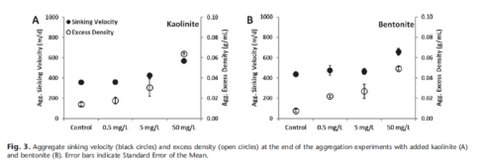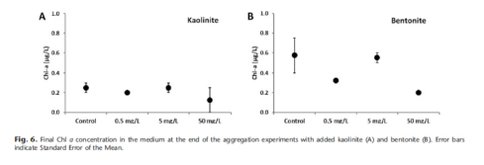2014 Annual Science Report
 Arizona State University
Reporting | SEP 2013 – DEC 2014
Arizona State University
Reporting | SEP 2013 – DEC 2014
Task 4: Biogeochemical Impacts on Planetary Atmospheres
Project Summary
Oxygenation of Earth’s early atmosphere must have involved an efficient mode of carbon burial. In the modern ocean, carbon export of primary production is dominated by fecal pellets and aggregates produced by the animal grazer community. But during most of Earth’s history the oceans were dominated by unicellular, bacteria-like organisms (prokaryotes) causing a substantially altered biogeochemistry. In this task we experiment with the marine cyanobacterium Synechococcus sp. as a model organism and test its aggregation and sinking speed as a function of nutrient (nitrogen, phosphorus, iron) limitation. We have found that these minute cyanobacteria form aggregates in conditions that mimic the open ocean and can sink gravitationally in the water column. Experiments with added clay minerals (bentonite and kaolinite) that might have been present in the Proterozoic ocean, show that these can accelerate aggregate sinking. In addition we find that Synechococcus could potentially export carbon 2–3 times of that contained in their cells via aggregation, likely due to the scavenging of transparent exopolymer particles and dissolved organic matter. Thus, aggregation and sinking by these small cyanobacteria could have constituted an important mode of carbon export in the Proterozoic ocean.
Project Progress
During this past year, we have completed a study on the aggregation of marine Synechococcus as a model organism, and the effects on the clays kaolinite and bentonite. The paper first authored by graduate student Wei Deng is about to be published in the journal Limnology and Oceanography.
We found that (1) Synechococcus cells formed aggregates as large as 1.4 mm in diameter that sank at velocities of up to 440 m d-1 and 660 m d-1 with and without ballasting clays, respectively; (2) clay minerals increased the number and reduced the size of aggregates, and their ballasting effects increased the excess density and sinking velocity of aggregates; (3) kaolinite, with its lower cation exchange capacity, resulted in a greater number of smaller and slower sinking aggregates compared to bentonite; and (4) based on our experimental conditions, Synechococcus could potentially export carbon 2–3 times of that contained in their cells via aggregation, likely due to the scavenging of transparent exopolymer particles and dissolved organic matter. The presented results have relevance for our understanding of the role of cyanobacteria in the ecology and biogeochemistry in today’s ocean and also elucidate mechanisms of carbon export in the early Proterozoic ocean.
We are also currently working on a manuscript on cell growth and the production of transparent exopolymeric particles (TEP), the main matrix of aggregates in Synechococcus cultures, under nutrient replete, nitrogen or phosphorus limited conditions. Aggregates were also investigated by direct microscopic observations and particle counter analysis, and their settling rates were determined using settling columns. Our results show that the TEP production increased when the cultures approached the stationary growth phase. In addition, we find that the cell-normalized TEP production in the nitrogen-limited cultures (10.9 ± 0.5 ×10-14 g/cell) was greater (T-test, P=0.05) than that in the nutrient replete condition (7.8 ± 0.9 ×10-14 g/cell), and the aggregates sank faster in the nitrogen-limited cultures.
Publications
-
Deng, W., Monks, L., & Neuer, S. (2015). Effects of clay minerals on the aggregation and subsequent settling of marine Synechococcus. Limnology and Oceanography, 60(3), 805–816. doi:10.1002/lno.10059
-
PROJECT INVESTIGATORS:
-
PROJECT MEMBERS:
Susanne Neuer
Project Investigator
Ariel Anbar
Co-Investigator
Ben Brugman
Collaborator
Wei Deng
Collaborator
Logan Monks
Collaborator
Uta Passow
Collaborator
-
RELATED OBJECTIVES:
Objective 4.1
Earth's early biosphere.
Objective 4.2
Production of complex life.
Objective 5.2
Co-evolution of microbial communities
Objective 6.1
Effects of environmental changes on microbial ecosystems
Objective 7.2
Biosignatures to be sought in nearby planetary systems


